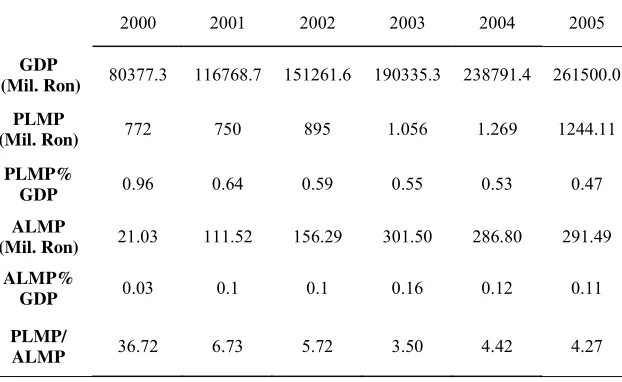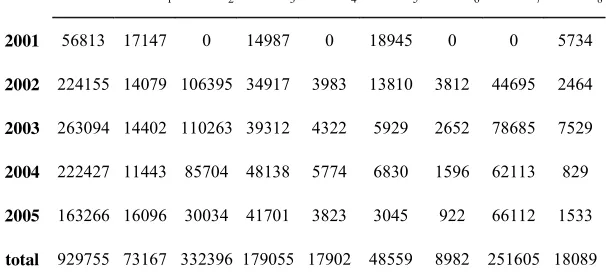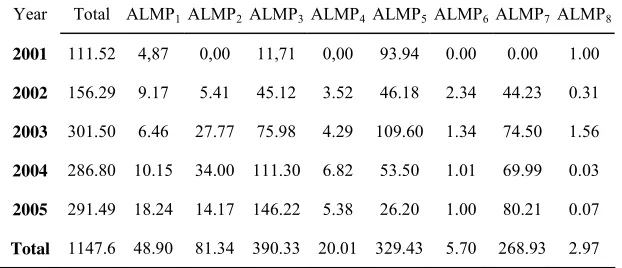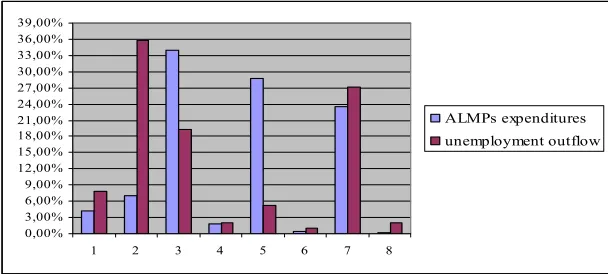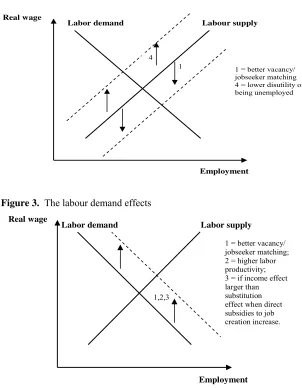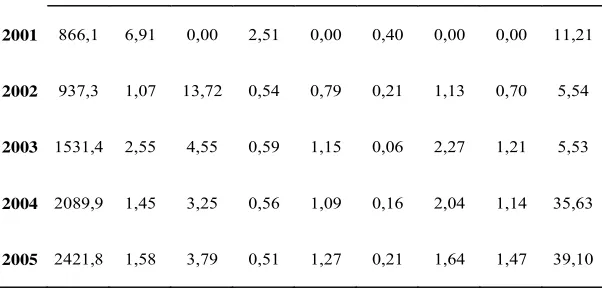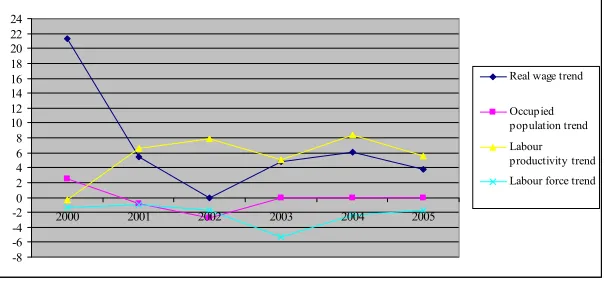Munich Personal RePEc Archive
The Impact of Active Labour Market
Policies in Romania
Bocean, Claudiu George
11 November 2007
Online at
https://mpra.ub.uni-muenchen.de/10397/
The Impact of Active Labour Market Policies
in Romania
Claudiu George Bocean, Lecturer, Ph. D
Faculty of Economics and Business Administration, University of Craiova
E-mail: boceanclaudiu@hotmail.com
Abstract. Following the predominance of macroeconomic
stabilisation policies and passive policies for alleviate the reform shock in the first phase of transition, active labour market policies (ALMPs) have now come to play a more important role in transition economies. In this paper I present a theoretical and empirical analysis of different types of active labour market policies (ALMPs). In my empirical analysis I use data on Romania covering the time period 2000-2005. I find that subsidized jobs are the most effective program to bring down unemployment. Labour market training and temporary employment in public works in community service have a positive impact. Despite their overall positive impact on unemployment rate, their budgetary cost is high and they are likely to be subject to diminishing returns as employment rates rise.
JEL code: E24, J64, J68
1. Introduction
work incentive and job search and therefore increase the risk of long-term unemployment. Active labour market policies aim at bringing unemployed back to work by improving the functioning of the labour market in various ways. ALMPs include programs such as public employment services, labour market training and subsidized employment. The 1994 OECD Jobs study recommends governments to “strengthen the emphasis on active labour market policies and reinforce their effectiveness” (OECD, 1994). The use of active labour market programmes is often motivated by the need to upgrade the skills of long-term unemployed in order to improve their employability.
Calmfors (1995) distinguishes four basic functions of ALMPs:
o raise output and welfare by putting unemployed to work or
have them invest in human capital,
o maintain the size of the effective labour force by keeping up
competition for available jobs,
o help to reallocate labour between different sub-markets, o and alleviate the moral-hazard problem of unemployment
insurance.
ALMPs may eliminate mismatch in the labour market, promote more active search behaviour on the part of the job seekers and have a screening function because they substitute for regular work experience in reducing employer uncertainty about the employability of job applicants.
Placements in labour market programs may provide an alternative work test to the eligibility of unemployment benefits, since some of those who are not genuinely interested in work will prefer to lose registration rather than to participate in a program. An adverse side effect of ALMPs is that workers are locked-in training and job-creation programs: because of their participation they reduce their search intensity (Boone and van Ours, 2004).
Then there are deadweight effects because labour market programmes subsidize hiring that would have occurred anyway in the absence of the program. There are also substitution effects because jobs created for a certain category of workers replace jobs for other categories because relative wage costs have changed.
Finally, there are the effects of taxation required to finance the programs on the behaviour of everyone in society.
Recent studies however are not very optimistic about the benefits of many of these programs. (Jan Boone, Jan C. van Ours, 2004).
Calmfors, Forslund and Hemström (2002) conclude that the evidence on the effectiveness of Swedish ALMPs is rather disappointing. Labour market retraining for example has no or negative employment effects.
In 1999, Stanley et al. summarize the quantitative effects of several U.S. ALMPs. Although the effects are quite low, they do find that temporary employment subsidy programmes increase the probability of finding jobs in the subsidy period, but they also find that there are no long-term effects. Likewise, Heckman et al. (1999) affirm that ALMPs may improve the economic situation for those with a weak position in the labour market, but for other socio-economic groups the effects are smaller if at all positive. They conclude that different types of programmes have different impacts.
There have been some studies on the impact of ALMPs in transition economies, but there is not an abundant number. From an overview of studies on labour-market reforms in transition economics Boeri (1997) show up that active policies, such as subsidized employment schemes and public work programs have not been very successful.
Kluve gives a detailed overview on large variety of different ALMP programs existing among EU member states and other European countries. It is possible to classify these programs into a set of six core categories (Kluve, 2006):
o training (classroom training, on-the-job training and work
experience);
o private sector incentive programs (measures aiming at
creating incentives to alter employer and/or worker behaviour regarding private sector employment);
o direct employment programs in the public sector (direct
creation and provision of public works or other activities that produce public goods or services);
o services and sanctions (measures aimed at enhancing job
search efficiency and matching);
o youth programs and for other disadvantaged groups
(programs for disadvantaged and youth unemployed, including training programs, wage subsidies and job search assistance);
o measures for the disabled (vocational rehabilitation,
sheltered work programs or wage subsidies for individuals with physical, mental or social disabilities).
Related to the previous observation, effects of ALMPs vary depending on the size of the programme (measured in terms of numbers of participants). Small (targeted) programmes seem to be more effective. Large size tends to have a negative impact on quality. This seems to be particularly true for youth programmes. Effects of ALMPs are country specific, depending on factors such as the general economic situation, level of unemployment, the quality of PES (Public Employment Service).
In this paper I investigate the effectiveness of active labour market policies on an aggregate level both from an empirical and a theoretical point of view. I study the effects of specific categories of ALMP.
The paper is set up as follows. Section 2 provides stylized facts about the system of passive and active labour market policies in Romania. Section 3 evaluates the aggregate effect of ALMPs on employment, labour force participation and unemployment and finds a positive correlation between spending on ALMPs as a percentage of GDP and the unemployment outflow. Section 4 gives final remarks.
2. Romanian Labour Market Policy
Apart from difficulties and delays during the 16 years of transition, Romania has, to a large extent, undertaken reform in all spheres: economically, politically, and socially. While the first 10 years were characterised by the restructuring of the economy (accelerated in 1997-1999), which suffered several crisis periods, a re-launching process was started in 2000. Macro-economic equilibrium, budget deficit, and the level of inflation have all been improved, along with a better coordination of budgetary and monetary policies. Restructuring has been gradually broadened to affect sensitive sectors and the privatisation process accelerated considerably and is now more advanced.
5.2% in 2003, 8.3% in 2004, and 4.2% in 2005 and for 2006 the value envisaged is 4.5%.
After being at an excessively high level, average inflation has been on a constant downward trend: from 40.7% in 2000 to 8.5% in 2005 and for 2006 the value envisaged is 6.5%.
Although real wage growth has lately become more aligned with productivity gains, the authorities are still struggling to control the wage bill of public enterprises. Wage developments and formation do not sufficiently reflect productivity differentials by skills, occupations and regions and therefore do not provide appropriate signals for skills acquisition or for regional and occupational mobility.
The existence of a dual labour market with a rural labour market concentrating more than 30 percents of the labour force and characterised by high participation, including in the younger and older age groups and very low unemployment (twice as low as in urban areas). Agriculture concentrates nearly half of private employment and 85% of all self-employed.
The restructuring of the economy has lead to a strong decline in industrial employment. Agriculture played a buffer role in absorbing the employment losses while due to the low growth and irregular development of the service sector, job growth has been negative and the reallocation of employment towards this sector has been marginal.
The skill level and structure of the labour force is a concern in an immediate and medium-term perspective. While the average educational level remains relatively low it increases since the mid 1990s; the qualifications held by many workers will not meet the requirements of the new jobs; the participation rate of young people in the education system is low at tertiary level, a certain group does not continue beyond compulsory education All these features represent a major challenge given the important restructuring ahead and the need to support economic transformation by a stronger development of new sectors.
Employment policy here is seen as widely defined – encompassing human resources policies, wages policy, the system of taxes and benefits, and the public employment service and its active labour market programmes.
Training and retraining measures for the unemployed were the first active measures put into place at the very beginning of the transition period. The need for other measures, enabling to support employment emerged progressively and became particularly urgent after 1996-1997 when the privatisation and the restructuring accelerated and resulted in massive lay-off. Romania then introduced recruitment incentives for hiring young graduates and loans to SMEs to recruit unemployed persons.
The new legal framework (Law 76/2002 on Unemployment Insurance and Employment Stimulation) build on the experience gathered through the World Bank supported projects and provided a broader framework for active labour market programmes, in particular by widening access to all unemployed and not only benefit recipients.
The implementation of ALMP was in the hands of the PES that had a network of district offices where every district office had a number of local centres.
Table 1. ALMPs and PLMPs expenditures related to GDP
2000 2001 2002 2003 2004 2005
GDP
(Mil. Ron) 80377.3 116768.7 151261.6 190335.3 238791.4 261500.0 PLMP
(Mil. Ron) 772 750 895 1.056 1.269 1244.11
PLMP%
GDP 0.96 0.64 0.59 0.55 0.53 0.47 ALMP
(Mil. Ron) 21.03 111.52 156.29 301.50 286.80 291.49 ALMP%
GDP 0.03 0.1 0.1 0.16 0.12 0.11 PLMP/
ALMP 36.72 6.73 5.72 3.50 4.42 4.27
1 Ron ≈ 3.5 Euro
Source: European Commission for Employment and Social Affairs and Department of Labour Romania (2005), “Second Joint Assessment of Employment Priorities in Romania” and www.insse.ro
The main active measures are recruitment incentives to employers, training and retraining programmes, benefits allotting to the unemployed who take up employment before the period of entitlement to the unemployment benefit, support to job creation in SMEs and to business start-ups, community work programmes and mobility grants.
Employment subsidies can be granted to employers for a maximum period of 12 months, at the request of local public authorities, for each unemployed person hired with an individual labour contract for community public services and social services. The subsidy is 70% of the minimum national wage for each unemployed person. Other recruitment subsidies for the young graduates, the disabled and those above 45 years differ in duration and level depending on the nature of the contract and its duration.
assistance and granting of low-interest loans (25-50% of the interest rate of the National Bank) for maximum 3 years. The counselling and assistance is free for unemployed receiving unemployment benefit. SMEs must recruit at least 50% of the new staff among registered unemployed.
Mobility grants correspond to a lump-sum payment amounting to two minimum wages if the unemployed takes up a job in a place distant from more than 50 km from the place of residence, to seven minimum wages if there is a change of residence.
[image:10.429.79.382.286.425.2]The outflow from unemployment through different types of ALMPs and the ALMPs expenditures are presented in Table 2 and Table 3.
Table 2. Outflow from unemployment through different types of ALMPs
Year Total ALMP1 ALMP2ALMP3ALMP4ALMP5ALMP6ALMP7 ALMP8
2001 56813 17147 0 14987 0 18945 0 0 5734
2002 224155 14079 106395 34917 3983 13810 3812 44695 2464
2003 263094 14402 110263 39312 4322 5929 2652 78685 7529
2004 222427 11443 85704 48138 5774 6830 1596 62113 829
2005 163266 16096 30034 41701 3823 3045 922 66112 1533
total 929755 73167 332396 179055 17902 48559 8982 251605 18089
3
Source: National Employment Agency: Yearly Employment Report (2001-2005)
ALMP1 - vocational training courses
ALMP2 - benefits allotting to the unemployed who take up employment
before the period of entitlement to the unemployment benefit ALMP3 - employers' subsidization
ALMP4 - stimulation of the labour force mobility
ALMP5 - granting loans to SME’s for new jobs creation
ALMP6 - counselling and assistance services for starting up an independent
activity or business
ALMP8 - other active measures
Table 3. ALMPs expenditures by types
-Mil Ron-
Year Total ALMP1ALMP2ALMP3 ALMP4 ALMP5 ALMP6ALMP7ALMP8
2001 111.52 4,87 0,00 11,71 0,00 93.94 0.00 0.00 1.00
2002 156.29 9.17 5.41 45.12 3.52 46.18 2.34 44.23 0.31
2003 301.50 6.46 27.77 75.98 4.29 109.60 1.34 74.50 1.56
2004 286.80 10.15 34.00 111.30 6.82 53.50 1.01 69.99 0.03
2005 291.49 18.24 14.17 146.22 5.38 26.20 1.00 80.21 0.07
Total 1147.6 48.90 81.34 390.33 20.01 329.43 5.70 268.93 2.97
Source: National Employment Agency: Yearly Employment Report (2001-2005))
3. Effectiveness of ALMP in Romania
Empirical work on the macroeconomic effects of ALMPs is rare. And, often no distinction is made between types of ALMPs. Instead, the focus is on total ALMPs expenditures. Following equation links variation in unemployment and types of ALMPs expenditures (Boone and van Ours, 2004):
u
it=
α
0+
α
1x
it+
α
2∆
2p
it+
ε
it(1)
where uit is the outflow from unemployment relate to different
types of ALMP expenditures i in a time period t. Furthermore, xit
refers to types of ALMP expenditures and ∆2pit is the change in
inflation rate. Finally, εit is the error term, which in most of the
studies is assumed to have a random effects specification.
member of the labour force (ignoring for simplicity the subscripts t) :
) 2 ( % l u almp N L L U GDP ALMP N GDP U ALMP x i i i
i = = = ×
where ALMPi represents types of expenditures on active
labour market policies, U is total unemployment, GDP is total gross domestic product, N is the population and L is the labour force. Finally, almp%i is each types of ALMPs expenditures as a
percentage of GDP, and l is the labour force participation rate (labour force as a fraction of the population).
In empirical analysis of different types of ALMPs it is important to compare ALMPs expenditures ratio and unemployed worker ratio (employ by ALMPs types).
[image:12.429.73.377.408.545.2]A comparison between ALMPs expenditures ratio and unemployed worker ratio (employ by ALMPs types) is presented in Figure 1.
Figure 1. Comparison between ALMPs expenditures ratio and unemployed worker ratio (employed by ALMPs types)
0,00% 3,00% 6,00% 9,00% 12,00% 15,00% 18,00% 21,00% 24,00% 27,00% 30,00% 33,00% 36,00% 39,00%
1 2 3 4 5 6 7 8
ALMPs expenditures unemployment outflow
Marcello Estevão (2003) considers that many of studies tends to overestimate the effect of ALMPs on the unemployment rate and very few studies focus on the most appropriate measure of labour market performance, the employment rate. Because of this I use for my comparative analysis of ALMP effectiveness employment-population rate, labour force participation rate and unemployment rate. There is a simple relationship between employment-population rate ep, labour force participation rate l and unemployment rate u:
ep = l(1
−
u) (3)
This relationship can be considered from two perspectives (Boone and van Ours, 2004). The first perspective is the point of view of a definition. Then, conditional on a constant labour force participation rate a fall in the unemployment rate by definition implies a rise in the employment-population rate. If the unemployment rate goes down and the employment-population rate remains constant then by definition the labour force participation rate must have gone down. The second perspective on this equation is the point of view of measurement. If unemployment refers to „open” unemployment and excludes unemployment in active labour market policies then a fall in unemployment might concern a spurious fall (Scarpetta, 1996). In this case the employment-population rate is a better indicator of labour market performance.
64.7% or the EU-25 average of 63.3% and above the new member states average of 56%.
Table 4. Employment rate, labour force participation rate and unemployment rate (with and without ALMPs effects)
2000 2001 2002 2003 2004 2005
Employment rate 63 62,4 57,6 57,6 57,9 57,7
Labour force
participation rate 70,9 68,6 64,1 62,3 62,1 61,3
Unemployment rate 11,2 9 10,2 7,6 6,8 5,8
Unemployment rate* - 9,6 12,6 10,5 9,3 7,6 Unemployment rate* - unemployment rate without ALMPs effects
Source: European Commission for Employment and Social Affairs ”Employment in Europe 2005 - Recent Trends and Prospects” and www.anofm.ro
According to the National Accounts data, employment in agriculture, forestry and fisheries still represents the bulk of total employment, with 31.2% in 2005, albeit falling from its all-transition period peak of 41.4% in 2000. The population employed in the tertiary sector (services, trade, banks, insurance, tourism, telecommunications, etc.) has been increasing and now accounts for 36.7% of total employment.
Industrial employment has witnessed its sharpest fall since 2000. In 2005, employment in industry and construction represented 32.1% of the total.
employed by the informal economy, plus 4 million in subsistence farming).
The high rates of idleness in the economically active age category, the great number of people working in subsistence farming and migration of labour (estimated at 2 million people) are occurrences that could account for the decrease in the number of people earning wages, without any corresponding growth in unemployment rates. A factor partly mitigating the effect of lay-offs from state-owned businesses was the development of private sector employment.
In accordance to the National Employment Agency data, unemployment rate decreased to 5.8% in 2005, compared with 6.8% the previous year. As a result, while the official unemployment rate will continue to remain low for a while, attention has to be paid to increasing the labour force participation rate for the working age population.
Unemployment has affected first and foremost workers, due to the industrial decline, where a large number of people were made redundant following the restructuring process, accounting for 73.8% in 2005 of the total number of registered unemployed persons.
Long-term unemployment (one year and over) saw an increase from 3.2% in 2001 to 4.2% in 2005. While overall unemployment is falling, long-term unemployment is constantly rising, thus forming a hard core mass of long-term unemployed towards which the ALMPs have to be focused during the coming years.
and a close monitoring is needed, in order to better assess the impact of early retirement on the activity rate and the sustainability of the pensions system placed under control only in the last years.
The ageing of population and increasing inactivity rate generate an increase in the economic old age dependency rate. While in 1990 there were 3.4 employees for 1 pensioner, in 2005 the ratio was 0.7 employees for 1 pensioner.
It is well-known that ALMPs have macroeconomic effects, i.e. the wage-setting behaviour and firms' vacancy supply or demand for labour may change (Calmfors, 1994; Calmfors and Lang, 1995; Holmlund and Linden, 1993). The literature provides arguments for both increased and decreased wage-pressure.
In short, increased wage-pressure stems from i) a more generous payment of programme participants than openly unemployed, implying that the welfare loss of becoming unemployed decreases; ii) an improved matching process implies lower expected hiring costs of the firms and hence the supply of vacancies increases which in general improves the employment perspectives for all unemployed workers leading to increased wage-pressure; and finally iii) a reduced risk of becoming long-term unemployed improves the employment perspectives for unemployed workers, and as the long-term unemployed are characterized by a lower matching probability than the short-term unemployed, we obtain increased wage-pressure. The reduced risk of becoming long-term unemployed, on the other hand, increases competition for the available jobs and thereby tends to decrease wage pressure. The net effect on wage-pressure is thus ambiguous.
Figure 2. The labour supply effects
Employment Real wage
1 = better vacancy/ jobseeker matching 4 = lower disutility of being unemployed Labour supply
Labor demand
4 1
Figure 3. The labour demand effects
Employment Real wage
1 = better vacancy/ jobseeker matching; 2 = higher labor productivity; 3 = if income effect larger than substitution effect when direct subsidies to job creation increase.
Labor supply Labor demand
1,2,3
Source: Estevão, Marcello (2003), Do Active Labour Market Policies Increase Employment?, IMF Working Paper, European Department, WP/03/234.
[image:17.429.77.363.289.474.2]more effective searching. The resulting smaller ratio between vacancies and unemployment reduces wage pressure, which causes a downward shift in the labour supply curve, and, because vacancies are costly to employers, provides an outward shift in labour demand. Both effects will tend to raise employment with an uncertain final effect on real wages.
Second, labour force productivity may increase, owing to either training programs or retraining, in the case of direct subsidies to job creation. This productivity increase would shift labour demand up and lift employment and wages.
Third, job creation programmes (e.g., direct employers'
subsidization, loans to SME’s for new jobs creation) may generate windfall effects (substitute for nonsubsidized
employment) making ALMPs ineffective. However, the associated income effect from an overall reduction in labour costs could be large enough to increase labour demand, implying higher wages and employment in equilibrium.
Fourth, active policies may lower the disutility of being unemployed, as they provide an occupation to otherwise unemployed workers, some income, and a hope of keeping their labour skills. Workers would then demand higher wages during bargaining and, in equilibrium, employment would be lower.
Even if a positive effect on employment might be discerned, the fiscal cost of ALMPs may be very high, raising the question of their overall effectiveness in a general equilibrium or cost-benefit sense (Table 5).
Effectiveness of different ALMPs types in a cost-benefit sense could be formulate in this way:
)
4
(
itt it
ALMP
PLMP
=
ε
where ALMPit represent costs to employ one unemployed
Table 5. Costs to employ one unemployed worker (by ALMPs types)
- Ron-
ALMP1 ALMP2 ALMP3 ALMP4 ALMP5 ALMP6 ALMP7 ALMP8
2001 284,2 0,0 781,3 0,0 4958,8 0,0 0,0 175,0
2002 651,6 50,8 1292,2 882,9 3344,2 615,0 989,6 125,8
2003 448,8 251,9 1932,7 992,6 18485,4 505,3 946,8 207,2
2004 887,0 396,7 2312,1 1181,2 7833,1 632,8 1126,8 36,2
2005 1132,9 471,7 3506,4 1408,5 8604,3 1088,2 1213,2 45,7
Source: Yearly Employment Report (2001-2005) at www.anofm.ro
On this viewpoint the most effectives ALMPs are training and retraining programmes, benefits allotting to the unemployed who take up employment before the period of entitlement to the unemployment benefit, support to job creation in SMEs and to business start-ups (εit>1). (Table 6)
Table 6. Effectiveness of ALMPs types
PLMP ALMP1ALMP2ALMP3ALMP4ALMP5ALMP6ALMP7ALMP8
2001 866,1 6,91 0,00 2,51 0,00 0,40 0,00 0,00 11,21
2002 937,3 1,07 13,72 0,54 0,79 0,21 1,13 0,70 5,54
2003 1531,4 2,55 4,55 0,59 1,15 0,06 2,27 1,21 5,53
2004 2089,9 1,45 3,25 0,56 1,09 0,16 2,04 1,14 35,63
[image:19.429.79.380.417.561.2]During five last years Romanian labour market had a contradictory evolution (Figure-4). Occupied population (labour market demand) and labour force (labour market supply) have been decreasing in recent years indicating that economic growth did not yet have positive effects on employment. However the unemployment rate decreased to 5.8% in 2005 thanks to a positive equilibrium between labour market demand and supply. Temporary and permanent migration is another element to take into account. Labour productivity exceeded real wage trend generating a plus of labour demand. ALMPs exerted a positive effect to labour market demand concurring to unemployment fall.
Figure 4. Real wage, occupied population, labour productivity and labour force trends
-8 -6 -4 -2 0 2 4 6 8 10 12 14 16 18 20 22 24
2000 2001 2002 2003 2004 2005
Real wage trend
Occupied population trend Labour productivity trend Labour force trend
Source: European Commission for Employment and Social Affairs ”Employment in Europe 2005 - Recent Trends and Prospects”, www.anofm.ro and own estimations
4. Conclusions
dimension of both employment and unemployment is of great concern for the future public action. While hidden unemployment may be high in particular in the agricultural sector and, more general, in the rural areas, actual employment, including those working in the large informal economy, is difficult to assess.
This paper has presented empirical evidence on the impact of ALMPs. The results show that, as expected, ALMPs seem to have been effective, on average, in decreasing unemployment rates. Among such policies, direct employers' subsidization to job creation and temporary employment in public works in community service seemed the most effectives.
Decision makers should clearly focus on the type of program in developing their ALMPs portfolio: Training programs should be continued, and private sector incentive schemes should be fostered. Particular attention should be paid to counselling and assistance services for starting up an independent activity or business and granting loans to SME’s for new jobs creation. Temporary employment in public works in community service, on the other hand, must decrease because are frequently damaging regarding participants' employment prospects.
However, even though ALMPs do decrease unemployment, they also weigh heavily on the budget. Institutional reforms to lower production costs and enhance labour market flexibility and work incentives are a better way to increase employment rates.
References
Barr N. (1994) “Labour Markets and Social Policy in Central and Eastern Europe”, New-York.
Boeri, T. (1997) “Labour-market Reforms in Transition Economies”, Oxford Review of Economic Policy 13: 126-140.
Boeri T. (1994) “Transitional Unemployment”, Economic of transition. 2: 1-25.
Burlea-Schiopoiu, Adriana and Bocean Claudiu (2005) Labour Economics, Craiova: EUC Press.
Calmfors Lars (1994) “Active labour market policy and unemployment - a framework for the analysis of crucial design features”, OECD Economic Studies 22: 7-47.
Calmfors L. and Lang H. (1995) “Macroeconomic Effects of Active Labour Market Programs in a Union-Wage setting Model”, The Economic Journal, Vol. 105, Issue 430: 601-619.
Calmfors L., Forslund A. and Herström M. (2002) “Does Active Labour Market Policy Work? Lessons from the Swedish Experiences,” Seminar Paper No. 700, Institute for International Economic Studies, Stockholm University.
European Commission for Employment and Social Affairs and Department of Labour Romania (2002), “Joint Assessment of Employment Priorities in Romania”, Bucharest.
European Commission for Employment and Social Affairs (2002), “Impact evaluation of the European Employment Strategy, technical analysis”, 416.
European Commission for Employment and Social Affairs and Department of Labour Romania (2005) “Second Joint Assessment of Employment Priorities in Romania”, Bucharest.
European Commission for Employment and Social Affairs (2006) “Employment in Europe 2005 - Recent Trends and Prospects”.
Estevão Marcello (2003) “Do Active Labour Market Policies Increase Employment?”, IMF Working Paper, European Department, WP/03/234.
Heckman J., Lalonde R. and Smith J. (1999), “The Economics and Econometrics of ALMP”, Handbook of Labour Economics, Vol. 3, North-Holland, Amsterdam.
Holmlund B and Linden J. (1993) “Job Matching, Temporary Public Employment and Equilibrium Unemployment”, Journal of Public Economics 51:329-343.
Kluve Jochen, and Schmidt Christoph (2002), “Can training and employment subsidies combat European unemployment?” Economic Policy 35: 411-448.
Kluve Jochen (2006) “The Effectiveness of European Active Labour Market Policy”, Discussion Paper 2018, IZA, Bonn, Germany.
Lalive Rafael, van Ours Jan, Zweimüller Josef (2000) “The Impact of Active Labour Market Programs and Benefit Entitlement Rules on the Duration of Unemployment”, Discussion Paper 149, IZA, Bonn, Germany.
Rosholm Michael and Svarer Michael (2004) “Estimating the Threat Effect of Active Labour Market Programmes”, Discussion Paper 1300, IZA, Bonn, Germany.
Scarpetta, Stefano (1996), “Assessing the role of labour market policies and institutional settings on unemployment: a cross-country study”, OECD Economic Studies 26: 43-98.
Stanley, M., L. Katz & A. Krueger (1999), Impacts of Employment and Training Programmes: The American Experience, Draft, Harvard University.
